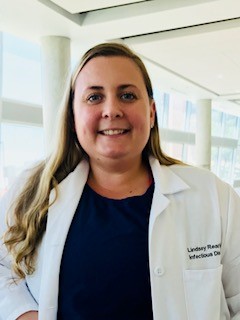
Lindsey Rearigh DO, UNMC First Year ID Fellow
We are excited to welcome Dr. Lindsey Rearigh as a new fellow in our Infectious Diseases program! Read on to learn a little more about her…
Tell us about the position you are starting
I am just starting my first year as an infectious disease fellow at UNMC. This is a 2-year program aimed at training its fellows in every area of infectious disease, from general ID to antibiotic stewardship, epidemiology and HIV.
Tell us about your background
I’m originally from Colorado, which is where most of my family still lives. I went to undergrad at Pfeiffer University in the tiny village of Misenheimer, NC where I played D2 lacrosse for four years. I then went to medical school at Edward Via College of Osteopathic Medicine (VCOM) in Spartanburg, SC and just completed my internal medicine residency at Mercy Medical Center in Des, Moines IA. I often say I have no true home because I have been bouncing around so much, but I enjoy learning about each new city and am excited to see how my two years in Omaha will turn out.
Why UNMC?
UNMC has an excellent reputation for ID training in the Midwest. The program touches on all areas of ID including rotations in general, oncology, ortho, and transplant. We also develop a strong base in HIV with weekly clinic time throughout the two years, as well as special opportunities for training in biopreparedness, antimicrobial stewardship and microbiology. It was important for me to choose a program that offered so many different opportunities so I can learn as much as I can during these two years to help better serve my future patients.
What about ID makes you excited?
ID is an amazingly diverse field that still utilizes every aspect of internal medicine training. I love that even though infectious disease is a specialty it still involves every organ system. I also get really excited about our patients and taking a really good history. We get to know our patients really well in this field because we are always asking questions about occupation, sex, travel, and pets. Some of the backstories that we get, even if it’s not related to why they are in our care, are very interesting. Often times getting to know these small details about our patients leads to better overall care and helps us overcome some barriers that may not have been addressed previously.
Tell us something about yourself unrelated to medicine
Outside of medicine, I enjoy pretty basic things like spending time with my family and friends, traveling and trying new things. I also really enjoy yoga. I find that it offers a nice balance to hectic call schedules, demanding patients and physician burnout. Yoga keeps me grounded in gratitude and focused on learning from everything. From new consults (even if in the middle of the night) to complex patients (even if not ID related) there is always something to learn. Wish me good luck on my journey over the next 2 years!
Learn more about the UNMC Infectious Diseases Fellowship here.
 The following is a review by one of our fellows
The following is a review by one of our fellows  accumulating slowly.
accumulating slowly. Based on the beta-lactam allergy history 50% of the patients received preferred beta-lactam agents during the baseline period. This number was increased to 60% during intervention period by careful evaluation by ASP team by history alone (P = .02). During the intervention period after implementation of BLAST, use of preferred beta lactam therapy further increased to 81% (P < .001). The authors concluded there were 4.5-folds higher odds of receiving preferred beta lactam therapy after implementation of BLAST without increase in side effects (95% CI, 2.4–8.2; P < .0001). During the intervention period use of agents with higher risk for C difficile infection such as fluoroquinolones and carbapenems decreased more than half (28% vs 13%; P < .0002) and penicillin use tripled (11% vs 32%; P < .0002).
Based on the beta-lactam allergy history 50% of the patients received preferred beta-lactam agents during the baseline period. This number was increased to 60% during intervention period by careful evaluation by ASP team by history alone (P = .02). During the intervention period after implementation of BLAST, use of preferred beta lactam therapy further increased to 81% (P < .001). The authors concluded there were 4.5-folds higher odds of receiving preferred beta lactam therapy after implementation of BLAST without increase in side effects (95% CI, 2.4–8.2; P < .0001). During the intervention period use of agents with higher risk for C difficile infection such as fluoroquinolones and carbapenems decreased more than half (28% vs 13%; P < .0002) and penicillin use tripled (11% vs 32%; P < .0002).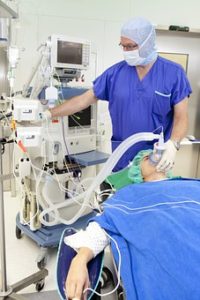
 Given the improvement in use of beta-lactams with just more intensive allergy history-taking, is the cost-effective solution simply just
Given the improvement in use of beta-lactams with just more intensive allergy history-taking, is the cost-effective solution simply just 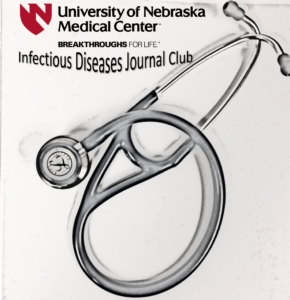
 Olivia: During my studies at UNL, I became interested in underserved communities after volunteering at the People’s City Mission (PCM) free health clinic. While at PCM, I interacted with patients who fell through the cracks in our healthcare system, a system that I have always been able to access. Soon after, I began to recognize disparity in my hometown of Columbus, NE in patients living in rural areas who struggle to meet with urban specialists to manage their health problems. Furthermore, my major of Global Studies took me to Mumbai, India where I met patients diagnosed with epilepsy who faced a great deal of social stigma surrounding their disease.
Olivia: During my studies at UNL, I became interested in underserved communities after volunteering at the People’s City Mission (PCM) free health clinic. While at PCM, I interacted with patients who fell through the cracks in our healthcare system, a system that I have always been able to access. Soon after, I began to recognize disparity in my hometown of Columbus, NE in patients living in rural areas who struggle to meet with urban specialists to manage their health problems. Furthermore, my major of Global Studies took me to Mumbai, India where I met patients diagnosed with epilepsy who faced a great deal of social stigma surrounding their disease. Rohan: My interest in health disparities largely stems from the time I spent as an undergraduate in St. Louis. Following the shooting of Michael Brown in Ferguson, a neighborhood 10-15 minutes from where I lived at the time, I became acutely aware that St. Louis, like Omaha, is a city with historically ingrained divisions that create disparities in the social determinants of its citizens’ health. I was inspired by the widespread activism I saw around St. Louis and involved myself in a narrative-based music outreach program to help uplift the stories of young community members. I was also motivated to leverage my own leadership positions on campus to advocate for the mental health of students of color and LGBTQ+ students.
Rohan: My interest in health disparities largely stems from the time I spent as an undergraduate in St. Louis. Following the shooting of Michael Brown in Ferguson, a neighborhood 10-15 minutes from where I lived at the time, I became acutely aware that St. Louis, like Omaha, is a city with historically ingrained divisions that create disparities in the social determinants of its citizens’ health. I was inspired by the widespread activism I saw around St. Louis and involved myself in a narrative-based music outreach program to help uplift the stories of young community members. I was also motivated to leverage my own leadership positions on campus to advocate for the mental health of students of color and LGBTQ+ students. Laura: Through volunteering at community organizations growing up, I became aware of differences in wealth, educational opportunities, and neighborhood resources between Omaha communities. During a college course in Ecuador which focused on social and political transformations, I gained a broader understanding of the global pervasiveness of inequalities, especially in health. In Minnesota where I attended college, I volunteered at a community health clinic teaching an exercise and nutrition class for Hispanic and Somali women struggling with obesity and diabetes. The hard work, persistence, and camaraderie of these women left me inspired and grateful for their friendship and the privilege to take part in their path to better health, and I felt drawn to a vocation in health care.
Laura: Through volunteering at community organizations growing up, I became aware of differences in wealth, educational opportunities, and neighborhood resources between Omaha communities. During a college course in Ecuador which focused on social and political transformations, I gained a broader understanding of the global pervasiveness of inequalities, especially in health. In Minnesota where I attended college, I volunteered at a community health clinic teaching an exercise and nutrition class for Hispanic and Somali women struggling with obesity and diabetes. The hard work, persistence, and camaraderie of these women left me inspired and grateful for their friendship and the privilege to take part in their path to better health, and I felt drawn to a vocation in health care. Independence Day is the
Independence Day is the  Hot Dogs/Deli meat: Staphylococcus aureus – causes nausea, vomiting, diarrhea, cramps within 30 minutes-6 hours
Hot Dogs/Deli meat: Staphylococcus aureus – causes nausea, vomiting, diarrhea, cramps within 30 minutes-6 hours Burgers: Escherichia coli – causes diarrhea, stomach cramps, vomiting within 3-4 days
Burgers: Escherichia coli – causes diarrhea, stomach cramps, vomiting within 3-4 days Step 1 – Clean: Wash your hands, utensils and food handling surfaces often
Step 1 – Clean: Wash your hands, utensils and food handling surfaces often Step 4 – Chill: Refrigerate your food promptly, and at most within 2 hours (within 1 hour if outside temperature is above 90°F). After cooking, put the food back in the cool refrigerator and make sure it can keep temperatures below 40°F. Food left at room temperature for long periods invites bacteria to multiply rapidly, increasing likelihood of foodborne illnesses.
Step 4 – Chill: Refrigerate your food promptly, and at most within 2 hours (within 1 hour if outside temperature is above 90°F). After cooking, put the food back in the cool refrigerator and make sure it can keep temperatures below 40°F. Food left at room temperature for long periods invites bacteria to multiply rapidly, increasing likelihood of foodborne illnesses. Most importantly, WASH YOUR HANDS before and after handling raw meat, before handling non-meat items, and before you sit down to enjoy the fruit of your grilling prowess. (Or at least use hand sanitizer!)
Most importantly, WASH YOUR HANDS before and after handling raw meat, before handling non-meat items, and before you sit down to enjoy the fruit of your grilling prowess. (Or at least use hand sanitizer!)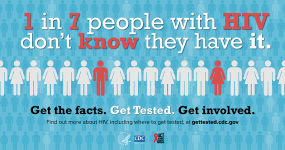 In 2006, the Centers for Disease Control and Prevention (CDC) recommended universal HIV screening, which was endorsed by the United States Preventive Services Taskforce (USPSTF) in 2013. Despite these recommendations, 1 in 7 persons living with HIV (PLWH) in the United States are unaware of their diagnosis. When stratified by age, young people between the ages of 13-24 account for
In 2006, the Centers for Disease Control and Prevention (CDC) recommended universal HIV screening, which was endorsed by the United States Preventive Services Taskforce (USPSTF) in 2013. Despite these recommendations, 1 in 7 persons living with HIV (PLWH) in the United States are unaware of their diagnosis. When stratified by age, young people between the ages of 13-24 account for  Our Specialty Care Clinic works closely with the Douglas County STD Clinic and NAP. We treat PLWH diagnosed with HIV at these locations and provide pre-exposure prophylaxis (PrEP) for patients who are at risk. Our nurse and case manager Precious Davis BSN, MSN has been very involved with reaching out to our community to spread the message of HIV testing. At an event in the Spring, Precious shared some of these statistics and information on treatment and stigma of HIV care in a poem (pictured here). At that event, 25 people were tested for HIV.
Our Specialty Care Clinic works closely with the Douglas County STD Clinic and NAP. We treat PLWH diagnosed with HIV at these locations and provide pre-exposure prophylaxis (PrEP) for patients who are at risk. Our nurse and case manager Precious Davis BSN, MSN has been very involved with reaching out to our community to spread the message of HIV testing. At an event in the Spring, Precious shared some of these statistics and information on treatment and stigma of HIV care in a poem (pictured here). At that event, 25 people were tested for HIV. The
The  Then it got worse. Around 1 week later, the cough started. The body aches. The headaches. The sore throat. The “influenza-like illness,” or ILI, arrived with no apologies. I thought the virus had done its worst; then, as I made my morning coffee, Wacky Wednesday started. I could not smell it. It seemed strange, but I thought it was just congestion. I took a sip. Hot liquid, tasteless. I rummaged through my kitchen–smelling and tasting noxious things, testing my senses. Garlic? Nothing. Chili Lime seasoning? Nothing. Pepper, salt, ginger? All nothing.
Then it got worse. Around 1 week later, the cough started. The body aches. The headaches. The sore throat. The “influenza-like illness,” or ILI, arrived with no apologies. I thought the virus had done its worst; then, as I made my morning coffee, Wacky Wednesday started. I could not smell it. It seemed strange, but I thought it was just congestion. I took a sip. Hot liquid, tasteless. I rummaged through my kitchen–smelling and tasting noxious things, testing my senses. Garlic? Nothing. Chili Lime seasoning? Nothing. Pepper, salt, ginger? All nothing.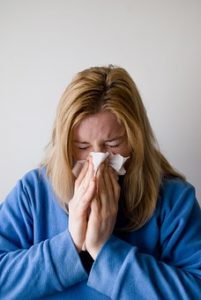 For most infections, think the common cold or upper respiratory infections, it seems that the post-infection loss of smell is generally temporary due to the phenomenal plasticity of the olfactory system. In fact, after URI’s, 32-66% of patients will recover their sense of smell spontaneously. For those struggling, training your sniffer can carry significant advantages toward recovering with intentionally smelling various types of odors a few times per day to “retrain” the olfactory system. It’s physical therapy for the nose!
For most infections, think the common cold or upper respiratory infections, it seems that the post-infection loss of smell is generally temporary due to the phenomenal plasticity of the olfactory system. In fact, after URI’s, 32-66% of patients will recover their sense of smell spontaneously. For those struggling, training your sniffer can carry significant advantages toward recovering with intentionally smelling various types of odors a few times per day to “retrain” the olfactory system. It’s physical therapy for the nose! After almost a year of planning, the First Annual Nebraska Antimicrobial Stewardship Summit convened on Friday, June 1st, 2018 in La Vista, NE. This conference is the first of its kind in Nebraska in which information on antimicrobial stewardship in various healthcare settings is the focus of the meeting. The conference center was abuzz with excitement as close to 270 healthcare professionals attended the Summit that included over 130 nurses, 80 pharmacists, and 30 providers. While the majority of the attendees were from Nebraska, healthcare professionals from neighboring states such as Iowa, Kansas, Missouri and South Dakota also attended the Summit.
After almost a year of planning, the First Annual Nebraska Antimicrobial Stewardship Summit convened on Friday, June 1st, 2018 in La Vista, NE. This conference is the first of its kind in Nebraska in which information on antimicrobial stewardship in various healthcare settings is the focus of the meeting. The conference center was abuzz with excitement as close to 270 healthcare professionals attended the Summit that included over 130 nurses, 80 pharmacists, and 30 providers. While the majority of the attendees were from Nebraska, healthcare professionals from neighboring states such as Iowa, Kansas, Missouri and South Dakota also attended the Summit. The morning session continued with presentations from Dr. Diekema (Professor, University of Iowa Carver College of Medicine, pictured to the left) on the Role of the Laboratory in Antimicrobial Stewardship; Drs. Vivekanandan (Associate Professor of Medicine, Creighton University) and Horne (Assistant Professor of Medicine, Creighton University) on “Is Antibiotic Stewardship the Answer to C. difficile”; and Kate Tyner, RN, CIC (Nurse Coordinator, Nebraska ASAP and ICAP) on the “Role of the Infection Preventionist in Antimicrobial Stewardship”. The morning session concluded with a presentation from Drs. Tierney and Pedati (Medical Epidemiologist, Nebraska DHHS) on “Public Health Support for Antimicrobial Stewardship” in which they discussed the state MDRO outbreak detection and management protocols as well as the state antimicrobial susceptibility registry and antibiogram.
The morning session continued with presentations from Dr. Diekema (Professor, University of Iowa Carver College of Medicine, pictured to the left) on the Role of the Laboratory in Antimicrobial Stewardship; Drs. Vivekanandan (Associate Professor of Medicine, Creighton University) and Horne (Assistant Professor of Medicine, Creighton University) on “Is Antibiotic Stewardship the Answer to C. difficile”; and Kate Tyner, RN, CIC (Nurse Coordinator, Nebraska ASAP and ICAP) on the “Role of the Infection Preventionist in Antimicrobial Stewardship”. The morning session concluded with a presentation from Drs. Tierney and Pedati (Medical Epidemiologist, Nebraska DHHS) on “Public Health Support for Antimicrobial Stewardship” in which they discussed the state MDRO outbreak detection and management protocols as well as the state antimicrobial susceptibility registry and antibiogram. During lunch, Summit attendees had the opportunity for roundtable discussions with
During lunch, Summit attendees had the opportunity for roundtable discussions with 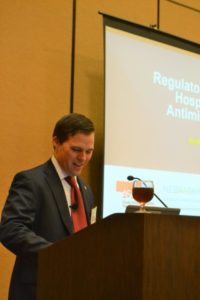 Education in antimicrobial stewardship continues in the afternoon with breakout sessions in the Acute and Ambulatory Track and the Post-Acute and Long-Term Care Track at the Summit. Dr. Bergman (Pharmacy Coordinator, Antimicrobial Stewardship Program, Nebraska Medicine, pictured to the left) started the acute and ambulatory session with his presentation on “Regulatory Requirements for Hospitals and Outpatient Antimicrobial Stewardship”. This was followed by presentations from Dr. Van Schooneveld (Medical Director, Antimicrobial Stewardship Program, Nebraska Medicine) on “Antimicrobial Stewardship Interventions in Acute Care Hospitals”; Dr. Kuper (Senior Clinical Manager, Infectious Diseases, Vizient) on “Antibiotic Stewardship Metrics: How Do You Measure Up?”; and Drs. Marcelin (Associate Medical Director, Antimicrobial Stewardship Program, Nebraska Medicine) and Green Hines (Medical Director, Antimicrobial Stewardship Program, Children’s Hospital & Medical Center) on “Antimicrobial Stewardship in the Outpatient Setting (#OutptASP)”. The session was well attended and appreciated by Summit attendees.
Education in antimicrobial stewardship continues in the afternoon with breakout sessions in the Acute and Ambulatory Track and the Post-Acute and Long-Term Care Track at the Summit. Dr. Bergman (Pharmacy Coordinator, Antimicrobial Stewardship Program, Nebraska Medicine, pictured to the left) started the acute and ambulatory session with his presentation on “Regulatory Requirements for Hospitals and Outpatient Antimicrobial Stewardship”. This was followed by presentations from Dr. Van Schooneveld (Medical Director, Antimicrobial Stewardship Program, Nebraska Medicine) on “Antimicrobial Stewardship Interventions in Acute Care Hospitals”; Dr. Kuper (Senior Clinical Manager, Infectious Diseases, Vizient) on “Antibiotic Stewardship Metrics: How Do You Measure Up?”; and Drs. Marcelin (Associate Medical Director, Antimicrobial Stewardship Program, Nebraska Medicine) and Green Hines (Medical Director, Antimicrobial Stewardship Program, Children’s Hospital & Medical Center) on “Antimicrobial Stewardship in the Outpatient Setting (#OutptASP)”. The session was well attended and appreciated by Summit attendees. Equally well attended is the post-acute and long-term care session that was opened with a presentation from Dr. Crnich (Chief of Medicine and Hospital Epidemiologist, Williams S. Middleton VA Hospital, pictured to the left) on “Regulatory Requirements for Post-Acute and Long-Term Care Antimicrobial Stewardship Programs”. This afternoon session continued with Dr. Ashraf (Co-Medical Director, Nebraska ASAP and Medical Director, Nebraska ICAP) speaking on “Antimicrobial Stewardship Implementation in Post-Acute and Long-Term Care Facilities”; Dr. Crnich on “Management of Common Infections in Long-Term Care Facilities”. The session concluded with a presentation from Tammi Schaffart, RN (Infection Control Nurse and QAPI Coordinator, Douglas County Health Center) and Dr. Ortmeier (Consultant Pharmacist Team Lead, Community Pharmacy Services) on the “Role of Nurses and Consultant Pharmacists in Antibiotic Stewardship in Post-Acute and Long-Term Care Facilities”.
Equally well attended is the post-acute and long-term care session that was opened with a presentation from Dr. Crnich (Chief of Medicine and Hospital Epidemiologist, Williams S. Middleton VA Hospital, pictured to the left) on “Regulatory Requirements for Post-Acute and Long-Term Care Antimicrobial Stewardship Programs”. This afternoon session continued with Dr. Ashraf (Co-Medical Director, Nebraska ASAP and Medical Director, Nebraska ICAP) speaking on “Antimicrobial Stewardship Implementation in Post-Acute and Long-Term Care Facilities”; Dr. Crnich on “Management of Common Infections in Long-Term Care Facilities”. The session concluded with a presentation from Tammi Schaffart, RN (Infection Control Nurse and QAPI Coordinator, Douglas County Health Center) and Dr. Ortmeier (Consultant Pharmacist Team Lead, Community Pharmacy Services) on the “Role of Nurses and Consultant Pharmacists in Antibiotic Stewardship in Post-Acute and Long-Term Care Facilities”. Track shared their thoughts. Dr. Crnich said it takes a team to establish a stewardship program while Dr. Ashraf (pictured to the left) echoed a similar sentiment that no one is alone in this journey. Tammi emphasized to the many nurses in the audience the importance of documentation to show their efforts for the numerous clinical activities they performed in nursing facilities, including antimicrobial stewardship. Dr. Ortmeier stressed the importance of persistence and the need to continue to ‘keep at it’ for eventual success.
Track shared their thoughts. Dr. Crnich said it takes a team to establish a stewardship program while Dr. Ashraf (pictured to the left) echoed a similar sentiment that no one is alone in this journey. Tammi emphasized to the many nurses in the audience the importance of documentation to show their efforts for the numerous clinical activities they performed in nursing facilities, including antimicrobial stewardship. Dr. Ortmeier stressed the importance of persistence and the need to continue to ‘keep at it’ for eventual success. We genuinely appreciate the support Summit attendees expressed. It is our hope that this type of Summit will continue annually in the future and that new topics and updated contents in antimicrobial stewardship will be presented. Additionally, we hope to make many more connections with healthcare professionals in Nebraska and neighboring states to improve the care and safety of our patients and residents by improving prescribing of this precious resource, antimicrobials, through antimicrobial stewardship.
We genuinely appreciate the support Summit attendees expressed. It is our hope that this type of Summit will continue annually in the future and that new topics and updated contents in antimicrobial stewardship will be presented. Additionally, we hope to make many more connections with healthcare professionals in Nebraska and neighboring states to improve the care and safety of our patients and residents by improving prescribing of this precious resource, antimicrobials, through antimicrobial stewardship.
Recent Comments